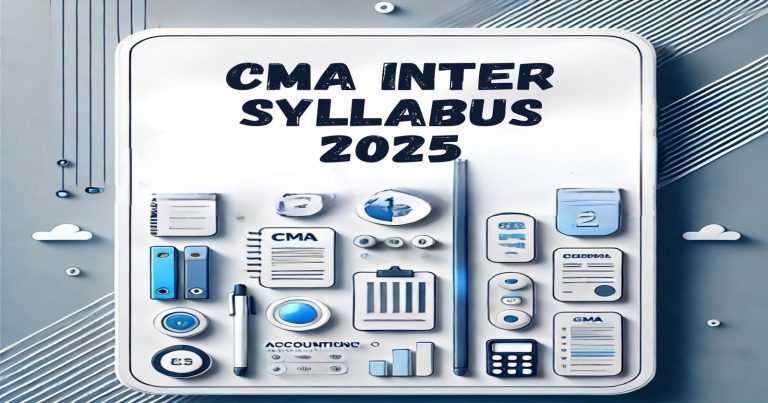The CMA Inter syllabus 2025 will be officially released by the Institute of Cost Accountants of India (ICMAI) on its website. Candidates preparing for the CMA Intermediate June 2025 session must strictly follow this updated syllabus, as the previous CMA Inter syllabus 2016 has been discontinued. Understanding the revised syllabus is crucial for effective preparation, as it forms an essential step toward becoming a certified management accountant. This updated syllabus not only builds a strong foundation in core CMA concepts but also equips students for advanced topics covered in the CMA Final level. In this article, we cover the latest updates, structure, and major components of the CMA Inter syllabus to help aspirants begin their studies with proper direction and confidence.
Structure of the CMA Inter Syllabus
Looking at the recent update, the syllabus for CMA intermediate stage includes a variety of subjects under various aspects of management accounting. Broadly, it consists of two groups that students must study, each of which comprises different subjects.
Group I
Below are the details of the CMA Inter Syllabus for Group I for different subjects, such as Financial Accounting, Law, Cost, Management, etc. Check out the detailed structure for the CMA Inter syllabus.
Paper 5 – Business Law & Ethics (BLE)
This paper introduces the legal and ethical framework within which graduates undertaking management accounting courses will operate. Some of the principles of this are the law of corporations, business ethics, and governance practices, keeping a special tangent view of regulatory and ethical issues in decision-making.
| Subject | Topics | Weightage |
| Commercial Laws | Introduction to Law and Legal System in India | 5% |
| Indian Contracts Act, 1872 | 10% | |
| Sale of Goods Act, 1930 | 5% | |
| Negotiable Instruments Act, 1881 | 5% | |
| Indian Partnership Act, 1932 | 5% | |
| Limited Liability Partnership Act, 2008 | ||
| Industrial Laws | Factories Act, 1948 | 10% |
| Payment of Gratuity Act, 1972 | ||
| Employees Provident Fund and Miscellaneous Provisions Act, 1952 | ||
| Employees State Insurance Act, 1948 | ||
| The Code on Wages, 2019 | ||
| Corporate Laws | Companies Act, 2013 | 40% |
| Business Ethics | Business Ethics and Emotional Intelligence | 15% |
Paper 6 – Financial Accounting (FA)
The paper encompass the areas of financial statement preparation and the application of various accounting standards. In addition, it includes accounting for assets, liabilities, equity, and analysis with reporting.
| Subject | Topics | Weightage |
| Accounting Fundamentals | Accounting Fundamentals | 15% |
| Accounting for Special Transactions | Bills of Exchange, Consignment, Joint Venture | 10% |
| Preparation of Financial Statements | Preparation of Final Accounts of Commercial Organisations, Not-for-Profit Organisations and from Incomplete Records | 20% |
| Partnership Accounts | Partnership Accounts | 20% |
| Lease, Branch and Departmental Accounts etc. | Lease Accounting | 15% |
| Branch (including Foreign Branch) and Departmental Accounts | ||
| Insurance Claim for Loss of Stock and Loss of Profit | ||
| Hire Purchase and Installment Sale Transactions | ||
| Accounting Standards | Accounting Standards | 20% |
Paper 7 – Direct and Indirect Taxation (DITX)
This assignment discusses the concepts and mechanisms of direct taxes. It offers the student knowledge of methods of tax planning, calculation of income subject to tax, and legislation on income tax. Moreover, this paper takes care of indirect taxes, such as customs charges and the Goods and Services Tax (GST). It covers subjects like compliance, tax structure, and effects on corporate operations.
| Subject | Topics | Weightage |
| Direct Taxation | Basics of Income Tax Act | 10% |
| Heads of Income | 25% | |
| Total Income and Tax Liability of Individuals & HUF | 15% | |
| Indirect Taxation | Concept of Indirect Taxes | 5% |
| Goods and Services Tax (GST) Laws | 35% | |
| Customs Act | 10% |
Paper 8- Cost Accounting (CA)
Knowledge of cost concepts, methods of cost accounting, budgeting, and cost control. This paper will bring in the applied management accounting techniques of variance analysis and cost-volume-profit analysis.
| Subject | Topics | Weightage |
| Introduction to Cost Accounting | Introduction to Cost Accounting | 5% |
| Cost Ascertainment – Elements of Cost | 15% | |
| Cost Accounting Standards (CAS 1 to CAS 24) | 10% | |
| Cost Book Keeping | 10% | |
| Methods of Costing | Methods of Costing | 30% |
| Cost Accounting Techniques | Cost Accounting Techniques | 30% |
Group II
Group II subjects include financial risk management, direct taxes, indirect taxes, and more. Here is the detailed structure of CMA Inter Syllabus Group II.
Paper 9: Operation Management & Strategic Management
The topics covered frameworks of strategic management, competitive analysis, and strategic decision-making. Students learn about strategic management, strategic planning, its implementation, and controlling.
| Subject | Topics | Weightage |
| Operations Management | Introduction | 5% |
| Operations Planning | 5% | |
| Designing of Operational Systems and Control | 5% | |
| Application of Operation Research – Production Planning and Control | 20% | |
| Productivity Management and Quality Management | 5% | |
| Project Management, Monitoring and Control | 15% | |
| Economics of Maintenance and Spares Management | 5% | |
| Strategic Management | Introduction | 10% |
| Strategic Analysis and Strategic Planning | 10% | |
| Formulation and Implementation of Strategy | 10% | |
| Digital Strategy | 10% |
Paper 10: Corporate Accounting and Auditing (CAA)
The paper focuses on the principles and practices of corporate accounting and auditing. It will give the student a holistic view of financial reporting, corporate compliance, and auditing standards. This preparation enables the learners to cope with complex accounting situations and guarantees competence in the management of corporate transparency and integrity.
| Subject | Topics | Weightage |
| Corporate Accounting | Accounting for Shares and Debentures | 10% |
| Preparation of the Statement of Profit and Loss and Balance Sheet (As Per Schedule III of Companies Act, 2013) | 10% | |
| Cash Flow Statement | 10% | |
| Accounts of Banking, Electricity and Insurance Companies | 10% | |
| Accounting Standards | 10% | |
| Auditing | Basic Concepts of Auditing | 10% |
| Provisions Relating to Audit under Companies Act, 2013 | 30% | |
| Auditing of Different Types of Undertakings | 10% |
Chapter 11: Financial Management & Business Data Analytics (FMDA)
It is one of the main themes of the course, which is about investment decisions and financial planning. Some of the issues covered here relate to working capital management, financial analysis, and capital budgeting.
| Subject | Topics | Weightage |
| Financial Management | Fundamentals of Financial Management | 5% |
| Institutions and Instruments in Financial Markets | 10% | |
| Tools for Financial Analyses | 15% | |
| Sources of Finance and Cost of Capital | 10% | |
| Capital Budgeting | 15% | |
| Working Capital Management | 15% | |
| Financing Decision of a Firm | 10% | |
| Business Data Analytics | Introduction to Data Science for Business Decision-making | 5% |
| Data Processing, Organisation, Cleaning and Validation | 5% | |
| Data Presentation: Visualisation and Graphical Presentation | 5% | |
| Data Analysis and Modelling | 5% |
Chapter 12: Management Accounting (MA)
This chapter delves into the principles, tools, and techniques used to analyze financial data, plan strategies, and evaluate performance, empowering managers to achieve business goals effectively.
| Subject | Topics | Weightage |
| Introduction to Management Accounting | Introduction to Management Accounting | 5% |
| Activity Based Costing | Activity Based Costing | 10% |
| Decision Making Tools | Marginal Costing | 30% |
| Applications of Marginal Costing in Short Term Decision Making | ||
| Transfer Pricing | ||
| Standard Costing and Variance Analysis | Standard Costing and Variance Analysis | 15% |
| Forecasting, Budgeting and Budgetary Control | Forecasting, Budgeting and Budgetary Control | 15% |
| Divisional Performance Measurement | Divisional Performance Measurement | 10% |
| Responsibility Accounting | Responsibility Accounting | 5% |
| Decision Theory | Decision Theory | 10% |
Major Updates for CMA Inter Syllabus
The CMA Inter syllabus has recorded some profound changes for 2025, modifying the dynamics of the accounting and taxation environment at large. The inset changes in the syllabus include:
New Accounting Standards Implemented: The syllabus was brought into accordance with the latest International Financial Reporting Standards and updates to the Indian Accounting Standards.
More Emphasis on GST and Other Indirect Taxes: Indirect taxes are currently under construction in India. So this syllabus ensures that more about GST and its effects on business enterprises is included.
Incorporation of Topics Regarding Strategic Management: The updated syllabus had more weight and focus on strategic management since it plays a very important role in the work of the management accountant.
CMA Inter Syllabus Exam Pattern 2025
The details of the latest exam pattern for CMA Inter Exam Pattern 2025 are to be known by the students. It is helpful to inform students about the mode of the exam, the number of questions, the test duration, the marking scheme, and other important information about the CMA Inter exam.
| Aspect | Details |
| Exam Mode | Online Center Based Examination |
| Question Types | Objective and descriptive |
| Maximum Marks | 100 |
| Number of Papers | 8 |
| Exam Duration | 3 hours per paper |
| Negative Marking | No |
With the issuance of CMA Inter Syllabus 2025, students can plan their study strategies effectively and increase their preparation for examinations. Getting details about changes and using the updated study resources will contribute much towards achieving success in the CMA Intermediate Exams.
CMA Inter Syllabus FAQs
What is the syllabus for CMA Inter?
CMA Inter syllabus is divided into two groups. Group I contains subjects like direct taxation, Financial accounting, Laws and Ethics, and Cost Accounting. Group II consists of Financial Management, Cost Management, Cost and Management Accounting, Operation Management and Strategic Management, Indirect Taxation, Company Accounts, and Audits.
Is CMA Inter easy?
The CMA Inter syllabus is not easy. You need hard work, dedication, and proper concentration to prepare for the CMA examination.
How many exams are in CMA Inter syllabus?
There are 8 exams in the CMA Intermediate syllabus.
Is there any negative marking in CMA Inter examinations?
No, there is no negative marking in the CMA intermediate exam.
What types of questions are asked in CMA Intermediate exams?
CMA Inter exams include both objective and subjective questions.


